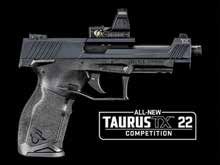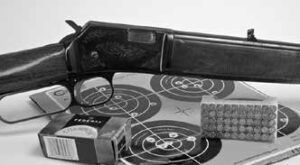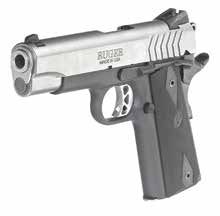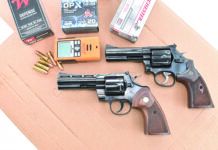Re “44 Magnum Pistols: New Taurus vs. Old Smith & Wesson,” September 2021
As an engineer, I am always interested in how things work. I thank Gun Tests for stating that the Model 29 “cylinder locks up at both ends.” So many gun writers falsely describe the positive latch in the front as a “detent.”
I own a 357 Combat Magnum made prior to S&W assigning model numbers. It seems to be similar to the Model 29 reviewed in the September issue of Gun Tests. Respectfully, I disagree with the statement that the “hammer is the rebounding type that does not make contact with the primer unless the trigger is depressed… It allows the revolver to be fully loaded because the hammer does not rest on a primer.”
The Rebounding Lock (hammer) was invented in 1867. The hammer’s “at rest position” is slightly back from the primer. I thought all revolvers had rebounding hammers, or they probably would not revolve. The firing pin would stop the rotation.
The concern with a fully loaded revolver was dropping the gun on the hammer, thereby pushing the hammer forward out of its “at rest position” and into the primer, causing a discharge. This is not prevented by a rebounding hammer. Modern revolvers have a transfer bar and frame-mounted firing pin, which prevents this type of inadvertent discharge.
My Combat Magnum, and probably the Model 29, has a hammer block, which performs the same function as the transfer bar, just in a different way. A hammer block blocks the hammer except when the trigger is pulled, thereby preventing inadvertent discharge. Looking down between the hammer and the frame as the trigger is pulled, you can see the hammer block move down and out of the way.
I think this is important for reader to understand because I have been told so many times that if the hammer has a firing pin attached, you should only load five rounds. This is not correct in the case of these revolvers. I believe it is important that the users understand why. — Bill
Bill: Thanks for the note and the questions. Let’s see if I can answer them.
1) Not all revolvers have rebounding hammers. The Colt Single Action Army is a great example wherein the firing pin is fixed to the hammer and which rests against the primer (potentially) when fully forward. The firing pin could indeed drag against the cartridges, except that the hammer must be cocked before the cylinder can be rotated.
2) The modern, current production Smith & Wesson Model 29 definitely has a frame-mounted firing pin, which can only contact the primers when the hammer comes fully forward and impinges on the firing pin. The trigger must be pressed and pressure maintained against the trigger for that to occur. When the pressure is released, the hammer rebounds away from any primer and is blocked by a hand inside the frame. The hand absolutely functions as a hammer block. I used the term “rebounding” because you can see the hammer block lift the firing pin back away from the cartridge case as pressure is released.
3) The Model 29 we used for this test has a serial number that dates to around 1972. It has a hammer-mounted firing pin — not one on the frame. Again, when the trigger is depressed and pressure is maintained, the hammer/firing pin moves forward, thereby contacting and igniting the primer then the cartridge. When pressure is released, the same type of hand as used on the frame-mounted firing pin causes the hammer to rebound and prevents its forward travel unless the trigger is activated by the shooter.
4) There is yet another system using a frame-mounted firing pin, a flat-faced hammer, and a transfer bar. In this case there is an actual gap between the hammer and the firing pin unless the trigger is duly pressed causing the transfer bar to rise into and fill the gap allowing the hammer to activate the firing pin.
5) All of these systems (with the exception of the Colt Single Action) allow the shooter to carry the revolver fully loaded with, in these cases, six rounds. Because the firing pins cannot touch the primer in the event of a drop, hammer-down fully-loaded carry is considered safe. Please be aware that all other safety rules still apply. — Joe Woolley
Competition 22 LR Pistols

Todd, a change of life at age 50 (28 years ago) brought me back to the range and specifically to Bullseye competition in Chantilly, Virginia and at the NRA Headquarters range, where weekly indoor matches were held. I started with an S&W 22A, and within a few months, I had bought a used Ruger Mark II Target that I outfitted with an improved trigger, grips, and an inexpensive red dot sight. With that setup, I improved to the high end of Expert rating. I organized Bullseye leagues at my gun club in Oklahoma and again in Winchester, Virginia. Along the way I’ve observed superb shooters using vintage High Standards, a Walther, several Ruger Mark series, and S&W Model 41s, among others. Now comes the Taurus TX22 Competition, an affordable target 22 LR pistol, and I’m considering trying one. Before I do, I hope to see it reviewed in Gun Tests, ideally head-to-head with some of the models I mentioned above. Any chance of that soon? — James
Hey James: To paraphrase one of our most infamous presidents, “It depends on what the meaning of the word ‘soon’ is.” I have shopped the idea to the staff and we’ll see what availability is. — tw
Re “For Defense: Shooting 45 Colt In Wheelguns and Leverguns,” October 2021
Gentlemen, I’ve been a subscriber since Todd was skinny. Now our builds are similar. I have read this article and wish to weigh in. The “combo” topic is excellent in so many ways. It seems to me that attention should be given to the 44 Magnum, chambered for revolvers and lever guns. In 1967, I bought my first hunting rifle, a Marlin 336T chambered in 44 Magnum. I bought it because I could afford it; the cost new was under $70. I had signed a contract paying me $4800 a year as a first-year teacher. Over the years, I have owned many rifles. Now, as a senior hunter, I find myself taking out that Marlin for Pennsylvania deer season. It is light, offers reasonable recoil, and is very effective within 100 yards. Today, Henry Repeating Arms offers a lever gun chambered for 44 Magnum. I understand that Ruger purchased the Marlin line from Remington, and hopefully Ruger will bring back a 44 Magnum lever gun. Also, I have owned several revolvers chambered for the 44 Magnum, and my current choice of a Model 629 Smith & Wesson with a 4-inch barrel serves me well. I can choose from among the many 44 Magnum loads for both guns, and the 44 Special offers a moderate-recoil option in the 629. Also, I can safely load that 629 with six rounds in the cylinder. Can that lever gun and revolver serve for home defense? They surely could, and I hope that it never becomes necessary. They are both welcome features in my collection of firearms. Like Colin Quinn said, “That’s my story and I’m sticking to it.” Keep up your good work. — Tom
Hey Tom: Thanks for sticking with us through thick and thin. — Todd Woodard
Re “Lever-Action Rimfires: Henry’s Golden Boy is Golden Indeed,” April 2008
Your comments about only some of the lever guns being able to shoot 22 Shorts, Longs, and Long Rifle cartridges puzzles me. Unless there is a problem with the feeding, why would they care? My old Marlin 39A will shoot them all. Comment: I have a Browning BL-22 and find it easy to bump the release button for the magazine follower and have it pop out, unless I rotate it to where it is protected directly under the barrel. — AF
 Hey AF: As we noted in the article, “All three guns will fire 22 Short, Long, and Long Rifle ammo. However, the shooter should use discretion when firing 22 Shorts in these guns. A continuous diet of this ammunition will cause carbon build-up at the end of the Short case, and in worse-case situations they will cause a ring to form in the chamber. This ring will cause extraction problems when Long Rifle ammunition is later fired.” In that test, the Browning BL-22 Grade II Lever Action 22 LR got a B+ grade, being overshadowed by the Henry Gold Boy Lever Action No. H004 22 LR, which was graded an A-. — tw
Hey AF: As we noted in the article, “All three guns will fire 22 Short, Long, and Long Rifle ammo. However, the shooter should use discretion when firing 22 Shorts in these guns. A continuous diet of this ammunition will cause carbon build-up at the end of the Short case, and in worse-case situations they will cause a ring to form in the chamber. This ring will cause extraction problems when Long Rifle ammunition is later fired.” In that test, the Browning BL-22 Grade II Lever Action 22 LR got a B+ grade, being overshadowed by the Henry Gold Boy Lever Action No. H004 22 LR, which was graded an A-. — tw
Re “9mm Single Actions: Tisas, Ruger, and Citadel Compete,” June 2021
 Regarding the grade of the Ruger SR1911 6722 9mm Luger, is the A+ still available when appropriate? Otherwise, how do we separate the good from the great? — Mike
Regarding the grade of the Ruger SR1911 6722 9mm Luger, is the A+ still available when appropriate? Otherwise, how do we separate the good from the great? — Mike
Mike, that’s a great question. In this case, the Ruger SR1911 was Our Pick, but it was the most expensive gun in the test. We generally reserve the A+ for super-performing guns that are also great values, so it’s very hard for a gun to earn an A+. We still will use the grade, but I look very, very hard at any A+ score that the testers award. — tw
Re “Go-Bag Rimfire Rifles from Savage, Ruger, and KelTec,” September 2020
I’ve had the KelTec Model SU-22CA rifle for a long while now but over the years there hasn’t been a lot of articles written on it. I really appreciate your thorough work. Bravo! — TZH
 For those who missed it, we tested the KelTec Model SU-22CA 22 LR in the September 2020 issue. We gave it an A- grade, saying of it, “While not a true takedown rifle, the folding stock on the SU-22CA makes it easy to stow and go. It performed flawlessly. There were mystery controls on the KelTec that were not intuitive. Fit and finish were not stellar, nor was the trigger, but we did get good accuracy. We felt it was a bit too pricey for the quality, but we did like this rifle.” — tw
For those who missed it, we tested the KelTec Model SU-22CA 22 LR in the September 2020 issue. We gave it an A- grade, saying of it, “While not a true takedown rifle, the folding stock on the SU-22CA makes it easy to stow and go. It performed flawlessly. There were mystery controls on the KelTec that were not intuitive. Fit and finish were not stellar, nor was the trigger, but we did get good accuracy. We felt it was a bit too pricey for the quality, but we did like this rifle.” — tw
Satisfied Reader
I have been a satisfied reader for several years. I am especially appreciative of the fact that you tell it exactly as you find it. I hope you never have to give in to the likes of the other gun magazines and provide a glowing report on a less-than-stellar gun. Thank you for your always-candid reporting of the good, the bad, and the ugly in the firearms world. — Newt
You are so welcome, Newt. We appreciate your support. — tw
Re “9mm Barrel Lengths Compared In Range Performance Testing,” September 2020
Your comparison of the 9mm versus the 357 Magnum in a 4-inch barrel compared to a 16-inch barrel helped me better understand the effects of unburned powder. According to your statistics, the 9mm makes the most efficient use of powder in a short barrel, as opposed to a 357. Thank you for your easy-to-understand explanation. — John
Re “Five-Shot 44-Caliber Revolvers From Ruger, S&W, and Taurus,” January 2018
Don’t overlook the Charter Arms Bulldog in 44 Special, especially the Classic Model. It’s a very compact, shootable 44-caliber gun. — Michael
Hey Michael: We tested the Charter Arms Bulldog Classic Model 34431 44 Special in the October 2016 issue. We said, “The Bulldog was compact and offered just enough grip for controllability.” Also, “Our Team Said: The Bulldog is a compact, accurate, and inexpensive defensive revolver, but the wobbly grip and rough-looking rear sight groove caused us to grade it lower.” We gave it a B- grade. — tw
Gun Tests Report Card Grading
Gun Tests Grade: A
A gun with this rating functions perfectly, shoots accurately, and exhibits comfortable, easy use for its owner. We may prefer one gun over others based on its unusual accuracy, superior performance, unusual features, or nice cosmetics. We recognize such a gun for these traits without regard to its cost.
Gun Tests Grade: B
We give this ranking to a gun that functions appropriately for its category, but which might not do as well in major areas as an A-ranked gun.
Gun Tests Grade: C
We may have reservations about some aspect of a gun’s performance or pricing. We express those reservations so the reader can balance our concerns with his or her needs.
Gun Tests Grade: D
Some aspect of a gun’s performance — in particular, safety, function, or accuracy — doesn’t meet our standards and isn’t easily resolved.
Gun Tests Grade: F
Some aspect of a gun’s performance is dangerous, inappropriate for the category, or is likely to fail.
We welcome mail from our readers. To send us comments or questions about previous articles in the magazine, email us at: GunTestsEditor@icloud.com. If you’ll include the month and year of the article you’re writing about, it’s a big help.
Also, please include your name, address, and phone number. We won’t publish your personal information other than your first name, but we may need to contact you about material in your letter. We really appreciate the quality and depth of thought our readers generate.





























I have 357 smith and Wesson revolver firing pin on the hammer can pin be replaced